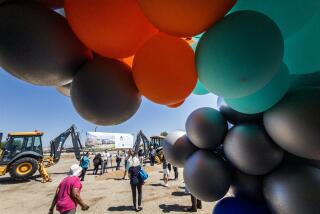DANA POINT : Students Get Look at Life in Biosphere 2
- Share via
Each morning inside the glass-enclosed, air-sealed Biosphere 2 project north of Tucson, Ariz., Mark Van Thillo wakes at 6:30, checks the system’s machines, eats some organic breakfast foods and works on the farm.
On Thursday, he took the time to talk by video teleconference to Capistrano Unified School District students about life inside Biosphere 2. The project is an experiment of ecological self-sufficiency that includes its own rain forest, desert and ocean.
“I feel very lucky I’m in here,” he told a group of excited students from Concordia Elementary School in San Clemente, who came to the Orange County Marine Institute for the teleconference.
Throughout the morning, students from other schools in the district also had a chance to learn more about Biosphere 2. The live video conferences were part of the 22nd annual Dana Point Festival of Whales, which continues through Sunday.
Van Thillo, co-captain and technical systems manager of the Biosphere 2 experiment, is among eight researchers who on Sept. 26, 1991, locked themselves into the three-acre structure in the foothills of the Catalina Mountains north of Tucson for a two-year stay.
The team--whose goal is to create a self-sufficient biospheric system for ecological research and a potential space station--is attempting to live off recycled air and water and to produce its own food, Van Thillo told the students.
Growing the food is the biggest challenge so far, Van Thillo said, because the structure’s glass frames block about 60% of the sun’s rays.
Van Thillo, of Belgium, said he has lost 30 pounds since entering Biosphere 2 and misses such things as chocolate bars and coffee, but he told the students that he could “stay in here a long time.”
In the past two weeks, Concordia students have been learning about the Biosphere 2 experiment, which has fit in easily with the school’s emphasis on environmental science, Principal Jeffrey Bristow said.
The $150-million privately funded project, deemed by some as a high-tech tourist attraction, has caused considerable debate since it was announced.
Most recently, an emergency supply of oxygen had to be pumped into the structure, and a special independent committee of scientists set up to advise the habitat resigned. The scientists said they were frustrated by a lack of cooperation from Biosphere 2 operators.
But such disputes did little to quell the students’ enthusiasm about the project and the experience of talking to someone live through the television.
“It was a good experience,” said sixth-grader Monica McDearmon, who said she would not mind living in Biosphere 2 herself. “I’ve never done anything like this before.”






